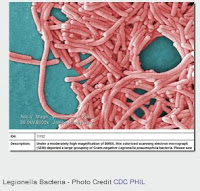#12,856
Yesterday the New York City Department of Health released a statement regarding a fresh outbreak of Legionnaire's disease - involving at least 12 patients - this time in downtown Flushing, Queens.
Legionella bacteria thrives in warm water, such as is commonly found in air-conditioning cooling towers, hot tubs, and even ornamental water fountains. When water is sprayed into the air the bacteria can become aerosolized and inhaled.You may recall that during the summer and fall of 2015, NYC saw no fewer than 3 outbreaks of this bacterial pneumonia - including one that resulted in 138 cases and 16 deaths - all linked to a single cooling tower in the South Bronx. As many people who contract this type of bacterial infection experience only minor symptoms, this was likely an under count of the total affected.
The CDC estimates that between 8,000 and 18,000 Americans are hospitalized with Legionnaire's Disease each year. Those most susceptible to serious illness are often older, smokers, or immunocompromised.
The abstract from a recent EID Journal article on that outbreak (Legionnaires’ Disease Outbreak Caused by Endemic Strain of Legionella pneumophila, New York, New York, USA, 2015) warned:
During the summer of 2015, New York, New York, USA, had one of the largest and deadliest outbreaks of Legionnaires’ disease in the history of the United States. A total of 138 cases and 16 deaths were linked to a single cooling tower in the South Bronx. Analysis of environmental samples and clinical isolates showed that sporadic cases of legionellosis before, during, and after the outbreak could be traced to a slowly evolving, single-ancestor strain.
Detection of an ostensibly virulent Legionella strain endemic to the Bronx community suggests potential risk for future cases of legionellosis in the area. The genetic homogeneity of the Legionella population in this area might complicate investigations and interpretations of future outbreaks of Legionnaires’ disease.Another recent EID Journal article (Legionnaires’ Disease Outbreaks and Cooling Towers, New York City, New York, USA) details the increasing number of outbreaks in NYC over the past two decades.
All of which brings us to the following statement from NYC's DOH. I've only posted some excerpts, so follow the link to read it in its entirety.
Health Department Investigates Community Cluster of Legionnaires' Disease in Downtown Flushing, Queens
12 confirmed cases of Legionnaires’ disease have been reported in the area in the past two weeks
Legionnaires’ disease cannot be spread from person to person; those at high risk include people aged 50 or older, especially cigarette smokers, people with chronic lung disease or with weakened immune systems
New Yorkers with respiratory symptoms, such as fever, cough, chills and muscle aches, are urged to promptly seek medical attention
October 24, 2017 — The Health Department is currently investigating a community cluster of Legionnaires’ disease cases in downtown Flushing, Queens. A total of 12 patients have been confirmed with Legionnaires’ disease in the area in the past two weeks. Most patients had serious underlying health conditions. The patients range in age from early 30s to late 80s. Five persons are hospitalized and recovering, and seven have been discharged from the hospital. No patients have died. Two more cases are currently being investigated to determine whether they are part of this cluster.
The Health Department is actively investigating these cases and has taken water samples from all cooling tower systems within the investigation zone to test for Legionella, the bacteria that causes Legionnaires’ disease. To raise awareness in the community, the Health Department and the Mayor’s Office are working with elected officials and sending outreach teams to transit hubs and senior centers in the area to distribute information about Legionnaires’ disease.
The Health Department is also organizing a community meeting to inform residents, answer questions and address any concerns. The Health Department is urging residents in the area with respiratory symptoms, such as fever, cough, chills and muscle aches, to promptly seek medical attention. The Health Department has alerted health care providers in the area about this cluster. Legionnaires’ disease is a treatable infection using antibiotics for pneumonia.
Every year, there are between 200 and 400 cases of Legionnaires’ disease in the city.
As of today, the Health Department has sampled all cooling towers in the investigation zone. Testing involves a two-step process that first identifies genetic evidence of the bacteria and then confirms if the bacteria are alive and able to cause disease. Positive results from the first step will enable the Health Department to identify towers that potentially have bacteria capable of making people sick. The owners of those buildings will be ordered to immediately increase the level of biocides that kill the Legionella bacteria or to change to a new biocide and report to the Department within 24 hours.
This biocide remediation will be done as a precautionary step while the second step, growing the bacteria in culture, is being done to determine the presence of the live bacteria that causes Legionnaires’ disease. It takes two weeks to allow bacteria adequate time to grow. A positive culture indicates the presence of bacteria capable of causing disease. The Department will order the owner of any building with a positive culture result to fully clean and disinfect the cooling tower.
(SNIP)
Legionnaires’ disease cannot be spread from person to person. Groups at highest risk for Legionnaires’ disease include people who are middle-aged or older, especially cigarette smokers, people with chronic lung disease or weakened immune systems and people who take medicines that weaken their immune systems (immunosuppressive drugs). Those with symptoms should call their doctor and ask about testing for Legionnaires’ disease.
(SNIP)
For more information about Legionnaires’ disease, please visit the Health Department website.
###
